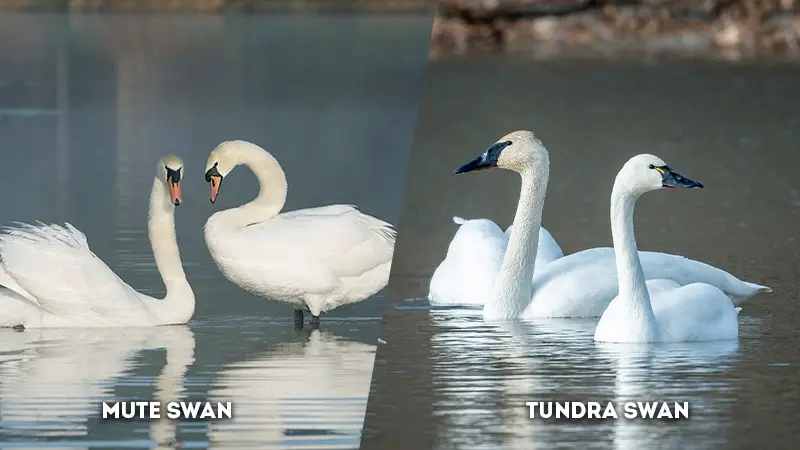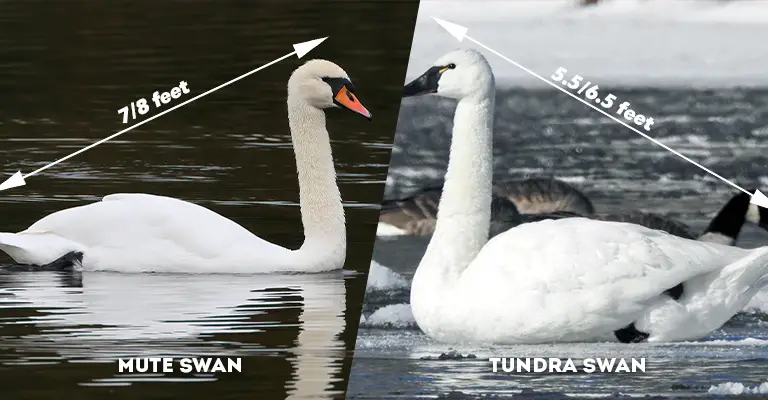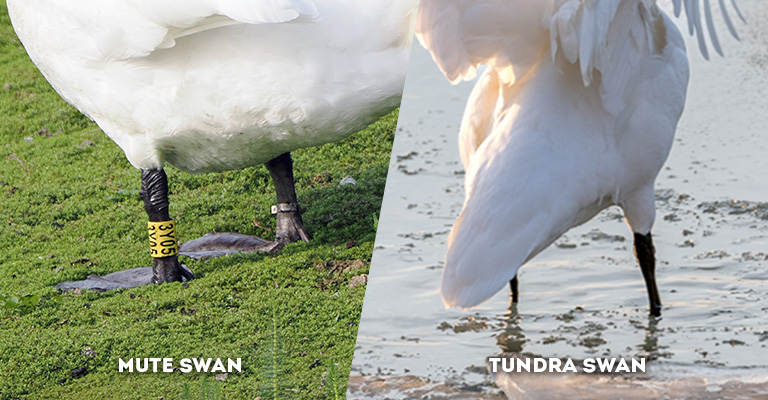Swans, graceful and majestic, epitomize the serene beauty of aquatic landscapes. Among them, Mute Swans and Tundra Swans stand as distinct avian icons, each bearing unique characteristics that set them apart.
From bill color to behavior, habitat preferences to migratory patterns, these two swan species showcase a captivating tapestry of adaptations and behaviors.
This exploration delves into the intricacies of their differences, unveiling the nuances that define Mute Swans’ elegant presence in temperate regions and Tundra Swans’ remarkable migrations between Arctic breeding grounds and North American winter havens.
Amid these variations lies a deeper understanding of how nature shapes these magnificent birds’ lives.

Key Differences Between Mute Swan and Tundra Swan
Here are some of the main differences between mute swans and tundra swans:
Size

- Mute Swan: Mute Swans are notably larger, boasting a wingspan of 7 to 8 feet and weighing between 20 to 30 pounds.
Their imposing size and graceful presence make them a prominent species in temperate habitats across Europe, and Asia and introduced populations in North America. - Tundra Swan: In contrast, Tundra Swans exhibit a smaller physique, with a wingspan of 5.5 to 6.5 feet and a weight ranging from 10 to 18 pounds.
These swans undertake remarkable migrations, journeying between their Arctic breeding grounds and wintering areas in North America.
Bill Color
- Mute Swan: The bill of the Mute Swan is a striking feature, adorned with an orange hue that culminates in a distinctive black knob at its base. This vibrant coloration sets it apart and contributes to its regal appearance.
Mute Swans are known for their elegance and are commonly found in temperate regions of Europe, Asia, and North America. - Tundra Swan: Conversely, the Tundra Swan exhibits a different bill coloration that plays a role in its identification.
Their bills are uniformly black, a contrast to the Mute Swan’s vivid orange. This characteristic, combined with their other features, distinguishes Tundra Swans from their Mute counterparts.
Neck Shape

- Mute Swan: The Mute Swan’s neck is renowned for its graceful curvature, forming an elegant S-shape.
This unique posture is one of the defining characteristics of the Mute Swan and contributes to its iconic appearance. The curved neck adds to its regal bearing and is often associated with its serene presence in still waters. - Tundra Swan: In contrast, the Tundra Swan holds its neck in a straighter posture. This subtle but distinct difference in neck shape gives the Tundra Swan a more elongated appearance when compared to the Mute Swan.
This straight-necked posture is especially noticeable during their migration and when they are swimming in open waters.
Tail Feathers
- Mute Swan: When it comes to tail feathers, Mute Swans are recognized for their long and pointed tail feathers.
These feathers, extending from their rear, contribute to their elegant profile and are often showcased when they fan them out during various behaviors, such as courtship displays or aggression. - Tundra Swan: Tundra Swans, on the other hand, display a different tail feather arrangement. Their tail feathers are shorter and more rounded, which contrasts with the elongated tail feathers of the Mute Swans.
This difference in tail feather shape contributes to the visual distinction between the two species, especially when observing them in flight or during their interactions.
Habitat
- Mute Swan: Mute Swans are commonly found in temperate regions, favoring habitats such as lakes, ponds, slow-moving rivers, and coastal waters.
Their graceful presence on these bodies of water often adds a touch of elegance to the landscape. They have become emblematic of serene, urban, and rural aquatic environments. - Tundra Swan: Tundra Swans, as their name implies, prefer vastly different habitats. During their breeding season, they inhabit the Arctic and subarctic tundra regions, often nesting near freshwater sources.
These swans undertake impressive migrations, flying thousands of miles to reach their wintering areas in North America, where they inhabit wetlands, coastal areas, and open waters.
Migration
- Mute Swan: Mute Swans are relatively sedentary in their habits, with many populations staying in their chosen habitats year-round. While some local movements might occur, they generally don’t undertake long migratory journeys like some other swan species.
- Tundra Swan: Tundra Swans, in contrast, are known for their remarkable migrations. These swans breed in the Arctic tundra during the warmer months and then undertake extensive journeys to their wintering areas in North America.
Their migratory flights can span thousands of miles and are a testament to their adaptability and endurance.
Vocalizations
- Mute Swan: Mute Swans are recognized for their deep and resonant calls, often described as trumpet-like or musical.
Their vocalizations contribute to their regal aura, and these sounds are commonly heard as they communicate with each other and with their environment. - Tundra Swan: Tundra Swans produce higher-pitched and more melodic calls compared to the Mute Swans.
Their vocalizations have a more musical quality and are distinctive in their own right. These calls play a role in various behaviors, such as communication within flocks and during courtship rituals.
Range
- Mute Swan: Originally native to Europe and Asia, Mute Swans have been introduced to various parts of North America and other regions.
They are now commonly found in temperate regions around the world, where they grace lakes, ponds, and rivers with their presence. - Tundra Swan: Tundra Swans are native to North America, particularly the Arctic and subarctic regions, where they breed.
Their migratory range takes them from these northern breeding grounds to wintering areas across North America, including coastal regions, wetlands, and lakes.
Leg Color

- Mute Swan: Mute Swans typically have black or grayish-black legs, which blend in with their dark plumage. This leg coloration complements their overall appearance and is a distinguishing feature in itself.
- Tundra Swan: Tundra Swans also have black legs, similarly contributing to their distinctive appearance. However, this leg color can stand out more against their white plumage, making them visually striking, especially when seen in snowy landscapes.
Leg Position
- Mute Swan: The legs of Mute Swans are positioned in a way that is more centered on their bodies. This alignment enables them to move gracefully both on water and land, as their legs are positioned directly beneath their bodies.
- Tundra Swan: Tundra Swans have their legs set farther back on their bodies. This positioning might be an adaptation to their Arctic habitat and could influence their movements, particularly in water. It’s a subtle but important distinction between the two swan species.
Feeding Habits
- Mute Swan: Mute Swans are primarily herbivores with a diet centered around aquatic vegetation. They graze on submerged plants, algae, and aquatic weeds.
Their long necks allow them to reach underwater plants easily, and they are known for their elegant and serene feeding behavior on lakes and ponds. - Tundra Swan: Tundra Swans exhibit a similar herbivorous diet, but they engage in both grazing and dabbling behaviors.
In addition to feeding on underwater vegetation, they also dabble at the water’s surface, feeding on submerged and emergent aquatic plants.
This versatility in feeding behaviors reflects their ability to adapt to different habitats during their migrations.
Nesting Sites
- Mute Swan: Mute Swans often choose nesting sites on islands within bodies of water or along the shores of lakes and rivers. Their choice of nesting locations offers protection from predators and potential disturbances, contributing to the survival of their offspring.
- Tundra Swan: Tundra Swans have different nesting preferences. They tend to build their nests on elevated areas within the Arctic tundra. This choice offers good visibility for spotting predators and ensures that their nests are situated in close proximity to vital freshwater sources.
Nesting Materials
- Mute Swan: Mute Swans construct their nests using a variety of materials, including reeds, grasses, and aquatic plants. These materials are skillfully woven together to create a sturdy and well-insulated nest structure.
- Tundra Swan: Tundra Swans also use grasses and sedges to build their nests. These materials provide insulation against the cold Arctic temperatures, helping to protect their eggs and young cygnets from the harsh environment.
Egg Color
- Mute Swan: Mute Swans lay eggs with pale greenish-blue shells. The coloration of their eggs is subtle and complements their white plumage, making them visually appealing within the nest.
- Tundra Swan: Tundra Swans lay eggs with creamy white shells. This coloration is likely an adaptation to their Arctic breeding environment, where white eggs would blend in with the snowy surroundings and provide better camouflage.
Egg Quantity
- Mute Swan: Mute Swans typically lay larger clutches of eggs, usually numbering between 5 to 7 eggs in a single nesting attempt. The larger clutch size might be related to the stability and protection provided by their chosen nesting sites.
- Tundra Swan: Tundra Swans lay smaller clutches of eggs, usually ranging from 3 to 5 eggs. This reduced clutch size might be a result of the challenging conditions they face in the Arctic tundra, where resources can be limited.
Cygnets (Young Swans)
- Mute Swan: Mute Swan cygnets are born with grayish-brown down feathers, often displaying pale stripes on their bodies. These markings provide camouflage and help them blend into their surroundings.
As they mature, their plumage gradually lightens, and they develop the iconic white feathers associated with Mute Swans. - Tundra Swan: Tundra Swan cygnets also have grayish-brown plumage, but their markings are darker in comparison to those of Mute Swans. This distinction in coloration contributes to differentiating the two species’ young, even as they grow and develop.
Neck Length
- Mute Swan: Adult Mute Swans are known for their longer necks relative to their body size, forming an elegant S-shape. This feature is a significant part of their identity and adds to their regal appearance on the water.
- Tundra Swan: Tundra Swans possess a neck that is relatively shorter in proportion to their body. While their necks are still elongated, they lack the pronounced S-shaped curvature of Mute Swans, giving them a more straight-necked and upright posture.
Bill Shape
- Mute Swan: The bill of the Mute Swan is slightly curved, adapting well for their feeding behaviors. This shape enables them to graze on underwater vegetation and reach aquatic plants efficiently.
- Tundra Swan: Tundra Swans have straighter and more pointed bills compared to the slightly curved bills of Mute Swans. This bill shape aligns with their feeding habits, allowing them to efficiently feed on both underwater and surface vegetation.
Behavior
- Mute Swan: Mute Swans are known for occasionally displaying aggressive behavior, especially during the breeding season when they might defend their territory. Their aggressive displays can include hissing, fluffing their feathers, and charging at perceived threats.
- Tundra Swan: Tundra Swans generally exhibit more peaceful behavior and are less prone to aggression compared to Mute Swans. Their interactions with other swans and wildlife tend to be less confrontational, contributing to a calmer demeanor.
Winter Behavior
- Mute Swan: In colder regions, some Mute Swan populations might migrate to milder areas to escape harsh winter conditions. However, in regions where they are established, they can withstand cold temperatures and may stay year-round.
- Tundra Swan: Tundra Swans are known for their remarkable winter migrations. As temperatures drop in their breeding grounds, they embark on journeys to warmer wintering areas, often traveling thousands of miles to reach more hospitable environments.
Conservation Status (N.a.)
- Mute Swan: Mute Swans have been introduced to various parts of North America, where they have established populations.
While admired for their beauty, their aggressive behavior and competition with native species have raised concerns in some areas about their impact on local ecosystems. - Tundra Swan: Tundra Swan populations in North America are generally stable, with some populations showing concern due to habitat loss and disturbances.
Conservation efforts focus on protecting their breeding and wintering habitats to ensure their continued survival.
Mute Swan Vs Tundra Swan: Comparison Table
| Feature | Mute Swan | Tundra Swan |
|---|---|---|
| Size | Larger: 7-8 ft wingspan, 20-30 lbs | Smaller: 5.5-6.5 ft wingspan, 10-18 lbs |
| Bill Color | Orange with black knob | Black |
| Neck Shape | Curved in S-shape | Straighter |
| Tail Feathers | Longer and pointed | Shorter and rounded |
| Habitat | Temperate ponds, lakes, rivers | Arctic tundra, wetlands |
| Migration | Generally sedentary; some local movement | Migratory between Arctic and winter areas |
| Vocalizations | Deep, resonant calls | Higher-pitched, musical calls |
| Range | Europe, Asia, introduced to North America | North America |
| Leg Color | Black or grayish-black | Black |
| Leg Position | More centered on body | Set farther back on body |
| Feeding Habits | Grazing on aquatic plants | Grazing and dabbling on vegetation |
| Nesting Sites | Near water on islands or shores | On elevated areas in tundra |
| Nesting Materials | Vegetation and reeds | Grasses and sedges |
| Egg Color | Pale greenish-blue | Creamy white |
| Egg Quantity | Typically 5-7 eggs | Usually 3-5 eggs |
| Cygnets (Young Swans) | Grayish-brown with pale stripes | Grayish-brown with darker markings |
| Neck Length | Shorter relative to body | Longer relative to body |
| Bill Shape | Slightly curved | Straight and more pointed |
| Behavior | Aggressive at times | Generally more peaceful |
| Winter Behavior | May migrate to warmer areas | Migrates south for winter |
| Conservation Status (N.A.) | Introduced and stable | Stable population, some concern |
Frequently Asked Questions
Mute Swans have deep and resonant calls that are often compared to trumpets, while Tundra Swans produce higher-pitched and more musical calls. These distinct vocalizations play a role in communication, especially during mating and territorial disputes.
Yes, they do. Mute Swans often form monogamous pairs and can be territorial during the breeding season.
Tundra Swans also exhibit monogamous behaviors, but they tend to be less territorial and more focused on raising their young in the Arctic tundra.
Mute Swans in established populations are well-adapted to cold climates and can withstand chilly temperatures.
Tundra Swans, on the other hand, undertake extensive migrations to escape the harsh Arctic winters, flying to warmer regions in North America for the colder months.
Mute Swans are not considered threatened; however, concerns about their aggressive behavior and competition with native species have prompted management efforts in some areas. Tundra Swans are generally stable, but certain populations may face threats due to habitat loss and disturbances.
Mute Swans play roles in shaping aquatic ecosystems through their feeding habits and interactions with aquatic vegetation. Their large size can also influence nutrient cycling in their habitats.
Tundra Swans have a similar ecological impact in their Arctic breeding grounds, where their foraging behaviors affect plant communities and nutrient distribution in wetlands.
To Recap
In the symphony of nature, Mute Swans and Tundra Swans compose their chapters with grace and purpose. Their contrasting features, from bill color to winter migrations, illuminate the diverse strategies these swans employ to thrive in their respective habitats.
Through the lens of these differences, we glimpse the remarkable intricacies of evolution’s brushstroke. Mute Swans bring regal elegance to temperate waters, while Tundra Swans orchestrate long journeys in search of milder climes.
Together, they remind us of the intricate interplay between species and environment, showcasing the enduring resilience and breathtaking beauty woven into the fabric of our natural world.